Do you have a question about the Roche ACCU-CHEK and is the answer not in the manual?
Details the components and intended use of the Accu-Chek Guide Me Blood Glucose Monitoring System.
Warns about small parts, keeping batteries away from children, and potential ingestion risks.
Outlines meter usage limitations and provides contact information for customer support.
Advises on therapy decisions based on results and warns against sharing the meter/lancing device due to biohazard risks.
Offers guidance for caregivers and initial steps before starting blood glucose testing.
Identifies and describes the front, back, and side views of the Accu-Chek Guide Me meter.
Illustrates and lists essential components like test strip container, strips, control solution, batteries, and USB cable.
Details the parts of the Accu-Chek FastClix Lancing Device, including the cap, dial, and drum.
Explains the functions and actions of the meter's power/set and arrow buttons.
Provides a guide to the various symbols displayed on the meter screen and their meanings.
Guides users through the process of setting the meter's time and date for accurate record-keeping.
Details the parts of the Accu-Chek FastClix Lancing Device and their basic functions for safe operation.
Provides step-by-step instructions for loading a new lancet drum and advancing to the first lancet.
Explains how to adjust the penetration depth and obtain a blood sample using the lancing device.
Details the procedure for safely removing and replacing a used lancet drum with a new one.
Covers critical safety warnings about device sharing and explains the units of measurement (mg/dL, mmol/L).
Provides general instructions for using the system and warnings to prevent inaccurate results.
Outlines the initial steps for performing a blood glucose test using blood from the fingertip.
Details the steps for applying blood to the test strip, viewing results, and post-test procedures.
Guides users on steps to take when blood glucose results do not match their physical condition.
Lists symptoms of hypo/hyperglycemia and explains how meter results compare to lab results.
Lists the specific situations that require performing a control test to ensure system accuracy.
Provides information on using, storing, and discarding control solutions.
Details the initial steps for performing a control test, including preparing the meter and test strip.
Explains how to apply control solution to the test strip and interpret the results displayed on the meter.
Describes how to confirm the control level and interpret 'OK' or 'Err' results based on the control range.
Offers checks and actions to resolve issues when control test results fall outside the expected range.
Explains how the meter stores blood glucose and control results, including memory capacity and deletion.
Guides users on how to access and scroll through stored blood glucose test results on the meter.
Details how to view 7, 14, 30, and 90-day average blood glucose results on the meter.
Explains the process of pairing the meter with a mobile device via Bluetooth.
Describes how test results are automatically sent to a paired mobile device.
Provides instructions for disabling Bluetooth on the meter.
Provides instructions for enabling Bluetooth on the meter.
Outlines the steps for transferring data from the meter to a PC using a USB cable and software.
Clarifies the distinction between cleaning (removing dirt) and disinfecting (reducing microorganisms).
Identifies Super Sani-Cloth as the approved product for cleaning and disinfecting the meter and lancing device.
Specifies the frequency and conditions for cleaning and disinfecting the meter.
Lists the specific areas of the meter that require cleaning and disinfecting.
Provides step-by-step instructions for safely cleaning and disinfecting the meter.
Outlines the frequency and conditions for cleaning and disinfecting the lancing device.
Lists the parts of the lancing device that should be cleaned and disinfected.
Provides step-by-step instructions for safely cleaning and disinfecting the lancing device.
Details the process for opening the battery compartment and replacing the meter's batteries.
Explains how error codes are displayed and provides general warnings regarding error messages.
Addresses issues such as the meter not turning on or timing out during a USB connection.
Covers problems with PC connection, mobile pairing, and results outside the measuring range (HI/LO).
Explains error codes E-1 and E-3, their causes, and recommended troubleshooting steps.
Details troubleshooting for error codes E-4, E-6, E-7, and E-8 related to sample application and temperature.
Explains error codes E-9 (battery) and E-10 (time/date sync) and their resolution.
Covers troubleshooting for error codes E-11 (strip damage), E-12 (ascorbate), E-13 (slot contamination), and E-14 (electronic error).
Lists technical specifications of the meter, including memory, power, dimensions, and product limitations.
Details the Bluetooth low energy technology used for meter communication and connectivity requirements.
Outlines the meter's compliance with electromagnetic emission standards and FCC rules.
Lists relevant safety standards (IEC) and warnings regarding electromagnetic fields and electrostatic discharge.
Provides guidelines for the proper disposal of the meter, test strips, lancing devices, lancets, and batteries.
Explains the meaning of various symbols that may appear on the meter or its packaging.
Lists available additional supplies and provides references for further information.
Details the 30-day money-back guarantee and the limited 3-year warranty for the meter.
Explains the service policy for out-of-warranty meters and instructions for returns.
Outlines the limited license for using the Accu-Chek Guide Me system in the US, including patent information.
Details the limited license for using the Accu-Chek FastClix system, including patent information.
| Display | LCD |
|---|---|
| Measurement Range | 10-600 mg/dL |
| Sample Size | 0.6 μL |
| Memory Capacity | 500 results |
| Battery Life | Approximately 1000 tests |
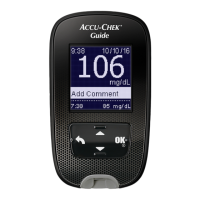

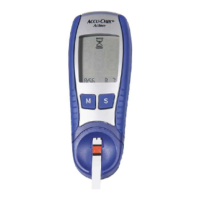


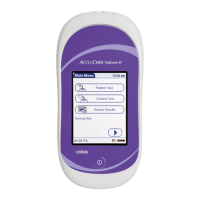
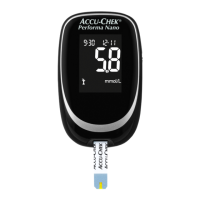

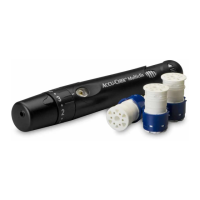

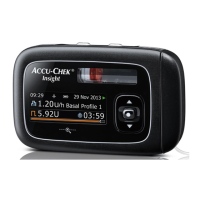
